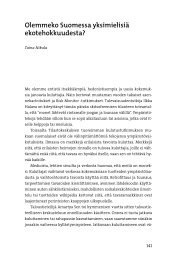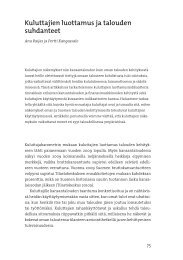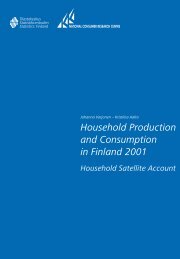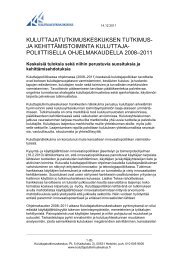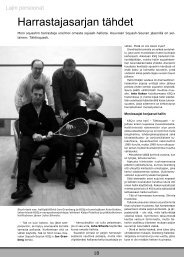Household Production and Consumption in Finland 2001
Household Production and Consumption in Finland 2001
Household Production and Consumption in Finland 2001
Create successful ePaper yourself
Turn your PDF publications into a flip-book with our unique Google optimized e-Paper software.
In the period from 1990 to <strong>2001</strong>, the share of labour <strong>in</strong> household production<br />
has decreased <strong>and</strong> the share of fixed capital consumption has <strong>in</strong>creased by a<br />
couple of percentage po<strong>in</strong>ts. This might suggest that households have <strong>in</strong>vested<br />
<strong>in</strong> mach<strong>in</strong>ery <strong>and</strong> equipment <strong>in</strong> order to reduce the amount of unpaid work.<br />
The figures are not fully comparable, however. In <strong>2001</strong>, the household capital<br />
also <strong>in</strong>cluded semi-durable goods, which <strong>in</strong> 1990 were placed under the<br />
head<strong>in</strong>g of <strong>in</strong>termediate consumption. There are also other differences <strong>in</strong> how<br />
purchased products are divided between <strong>in</strong>termediate consumption, capital<br />
goods <strong>and</strong> f<strong>in</strong>al consumption goods. In 1990, taxes <strong>and</strong> subsidies were not<br />
taken <strong>in</strong>to account. When the figures for <strong>2001</strong> are so revised that semi-durable<br />
goods are added to <strong>in</strong>termediate consumption <strong>and</strong> the correspond<strong>in</strong>g reduction<br />
is made to the consumption of fixed capital, the share of <strong>in</strong>termediate<br />
consumption rises to 22 per cent <strong>and</strong> the consumption of fixed capital drops<br />
back to 3 per cent.<br />
The structure of production is probably quite slow to change because novel<br />
household appliances that radically reduce the amount of unpaid work do not<br />
appear <strong>in</strong> the market very often. Examples of such appliances are the<br />
automatic wash<strong>in</strong>g mach<strong>in</strong>e, which began to ga<strong>in</strong> ground <strong>in</strong> the 1970s, <strong>and</strong> the<br />
microwave oven some ten years later. Another factor contribut<strong>in</strong>g to the slow<br />
pace of change is that people are slow to change their habits <strong>and</strong> rout<strong>in</strong>es.<br />
Sometimes it may take a whole generation for new customs to develop. The<br />
<strong>in</strong>creas<strong>in</strong>g use of purchased services might be the next major step towards a<br />
reduced level of unpaid work. In <strong>2001</strong>, such services still had only marg<strong>in</strong>al<br />
significance (Varjonen et al. 2005).<br />
5.2 <strong>Household</strong> production by pr<strong>in</strong>cipal<br />
function<br />
Provid<strong>in</strong>g hous<strong>in</strong>g is the biggest s<strong>in</strong>gle function <strong>in</strong> households. This may reflect<br />
the need of solid hous<strong>in</strong>g <strong>in</strong> F<strong>in</strong>l<strong>and</strong>’s harsh weather. Also, one <strong>in</strong> four<br />
households have a summer cottage as secondary dwell<strong>in</strong>g, many of which have<br />
lately been equipped so that they can be used all year round<br />
(Melasniemi-Uutela 2004). The second biggest function is the production of<br />
meals <strong>and</strong> snacks. Cloth<strong>in</strong>g, care <strong>and</strong> volunteer work each amount to no more<br />
than around one-fifth of production <strong>in</strong> the former two categories, <strong>and</strong> the care<br />
of pets is the smallest function. Compared to 1980, the provision of meals <strong>and</strong><br />
snacks as a proportion of total household production has decreased, while the<br />
share of hous<strong>in</strong>g has <strong>in</strong>creased (Varjonen & Aalto 2005).<br />
The total output of hous<strong>in</strong>g services is pushed up by the consumption of<br />
fixed capital (depreciation of hous<strong>in</strong>g as well as home furnish<strong>in</strong>gs <strong>and</strong><br />
equipment) <strong>and</strong> <strong>in</strong>termediate consumption, a large proportion of which<br />
consists of rents paid, repairs <strong>and</strong> heat<strong>in</strong>g. Care of children <strong>and</strong> adults seems to<br />
account for a relatively modest part of total household production if<br />
considered aga<strong>in</strong>st the media attention it attracts. However, the true value of<br />
care is greater than <strong>in</strong>dicated by the figures shown here s<strong>in</strong>ce only childcare<br />
<strong>and</strong> care of adults reported as a primary activity are <strong>in</strong>cluded. The <strong>in</strong>clusion of<br />
care as a secondary activity would double the value of output. Moreover, the<br />
care of elderly parents who live <strong>in</strong> their own households is def<strong>in</strong>ed as “help<strong>in</strong>g<br />
National Consumer Research Centre Statistics F<strong>in</strong>l<strong>and</strong> 35




